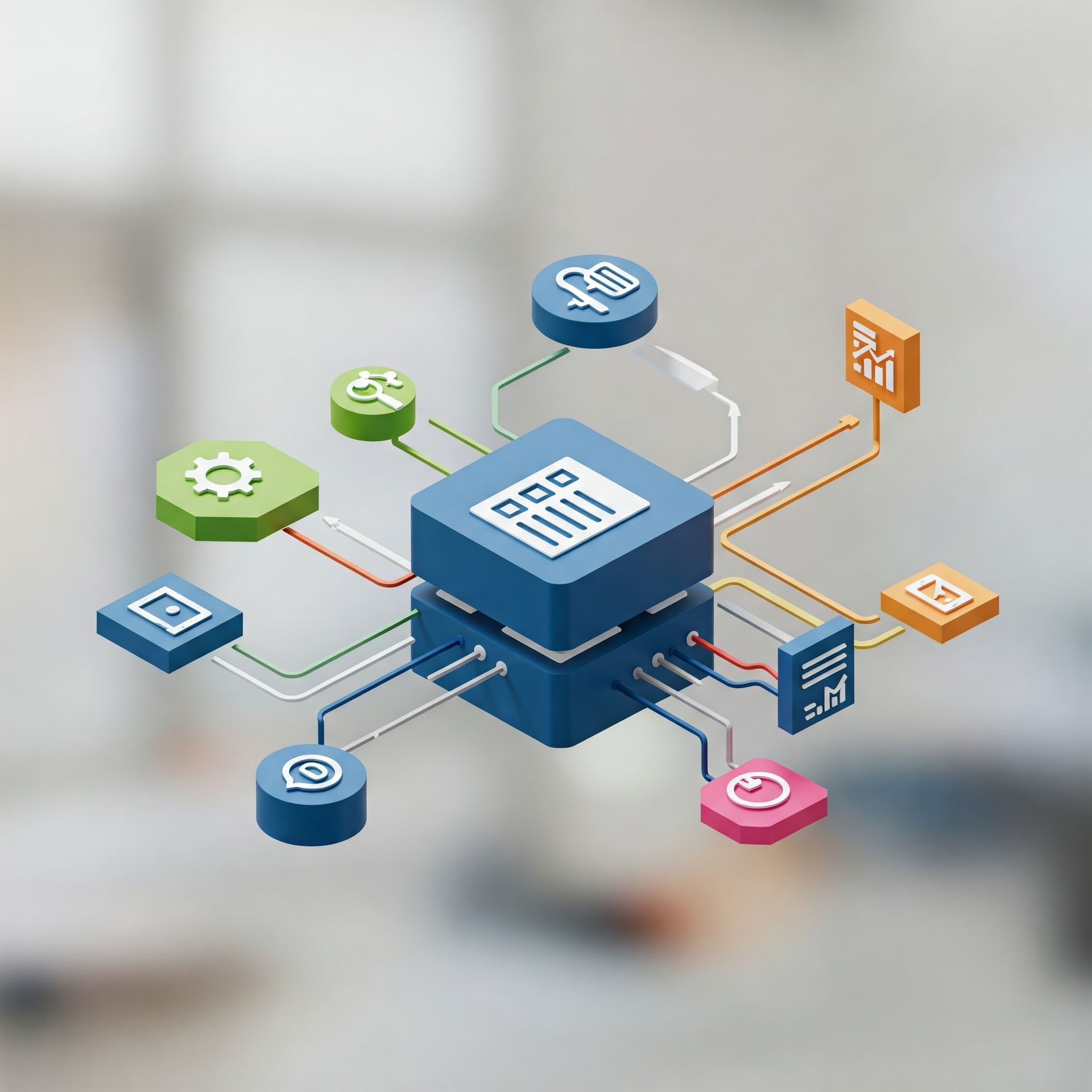Oracle Tax Reporting: Mastering the Return to Accrual Process
Nadia Lodroman • 8 April 2025
Listen to Tresora and Ledgeron's chatting about this blog post:
Boosting Efficiency and Accuracy in Your End-to-End Tax Provision
In the intricate world of corporate tax, the Return to Accrual (RTA)
process stands as a critical bridge between financial reporting and tax compliance. It’s the crucial step where temporary differences between book and tax accounting are analysed, leading to the calculation of deferred tax assets and liabilities.
Traditionally, this process can be time-consuming, error-prone, and heavily reliant on manual spreadsheets. However, with Oracle Tax Reporting (TRC), organisations can transform their RTA process, unlocking unprecedented levels of accuracy and efficiency.
This article delves into how Oracle Tax Reporting empowers tax professionals to navigate the complexities of the RTA, leveraging its robust features to automate tasks, ensure data integrity, and ultimately streamline this vital step in the tax provision lifecycle.
The Challenges of a Manual RTA Process:
Before exploring TRC capabilities, it's important to acknowledge the pain points often associated with manual RTA processes:
- Data Silos: Information needed for the RTA often resides in disparate systems (GL, sub-ledgers, tax workpapers), requiring significant effort to gather and consolidate.
- Spreadsheet Dependency: Reliance on spreadsheets introduces the risk of formula errors, version control issues, and limited audit trails.
- Time-Consuming Analysis: Manually identifying and analyzing temporary differences can be a laborious and resource-intensive task.
- Reconciliation Headaches: Reconciling the RTA to the trial balance and other supporting documentation can be a significant challenge.
- Lack of Transparency and Control: Manual processes often lack the visibility and control needed for effective review and governance.
Oracle Tax Reporting: A Catalyst for RTA Transformation:
Oracle Tax Reporting offers a centralised and integrated platform designed to overcome these challenges and elevate the RTA process. Here's how:
1. Automation at its Core:
TRC's automation features significantly reduce manual intervention in the RTA process:
- Automated Data Integration: Seamlessly connect to various source systems (GL, ERP, sub-ledgers) to automatically pull relevant financial data, eliminating the need for manual data gathering and entry.
- Pre-built Calculations and Logic: Configure rules and calculations within TRC to automatically identify and categorize temporary differences based on predefined criteria. This reduces the risk of human error and ensures consistency.
- Workflow Automation: Define and automate the RTA workflow, including review and approval processes, ensuring timely completion and clear accountability.
- Automated Journal Entry Creation: Once the RTA analysis is complete, TRC can automatically generate the necessary journal entries for posting to the general ledger.
2. Robust Data Reconciliation Capabilities:
Accuracy in the RTA process hinges on robust data reconciliation. TRC provides powerful tools to ensure data integrity:
- Trial Balance Integration and Reconciliation: Easily import and reconcile trial balance data against the RTA analysis, highlighting any discrepancies for investigation.
- Variance Analysis: Configure thresholds and generate variance reports to quickly identify significant changes in temporary differences, facilitating focused review.
- Drill-Down Functionality: Investigate the underlying details of account balances and temporary differences with intuitive drill-down capabilities, tracing data back to its source.
- Audit Trails: Maintain a comprehensive audit trail of all changes made within the system, providing transparency and supporting compliance requirements.
3. Ensuring Accuracy and Streamlining Efficiency:
By leveraging automation and robust reconciliation features, TRC directly contributes to both accuracy and efficiency in the RTA process:
- Reduced Errors: Automation minimizes the risk of manual data entry errors and calculation mistakes, leading to more accurate deferred tax balances.
- Faster Turnaround Times: Automating repetitive tasks and streamlining workflows significantly reduces the time required to complete the RTA.
- Enhanced Collaboration: A centralized platform facilitates better communication and collaboration among tax team members.
- Improved Visibility and Control: Real-time dashboards and reporting provide greater visibility into the RTA process, enabling better monitoring and control.
- Focus on Strategic Analysis: By freeing up time spent on manual tasks, tax professionals can focus on more strategic analysis and value-added activities.
Key Features in Oracle Tax Reporting for Mastering the RTA
- Tax Provision Matrix: A central hub for managing all aspects of the tax provision, including the RTA.
- Deferred Tax Automation: Specific modules and functionalities dedicated to automating the identification and calculation of deferred taxes.
- Data Source Integration: Flexible options for connecting to various GL and sub-ledger systems.
- Reporting and Analytics: Comprehensive reporting capabilities to analyze RTA data, track trends, and provide insights.
- Security and Controls: Robust security features to ensure data integrity and compliance with internal controls.
Conclusion:
The Return to Accrual process is a cornerstone of accurate financial reporting and tax compliance. Oracle Tax Reporting offers a powerful solution to transform this traditionally complex and time-consuming task. By embracing automation, leveraging robust data reconciliation capabilities, and providing a centralised platform, TRC empowers tax professionals to achieve unprecedented levels of accuracy and efficiency in their RTA process. This not only reduces risk and improves compliance but also frees up valuable time for strategic analysis and ultimately strengthens the overall tax function. If your organization is seeking to optimise its tax provision process, exploring the capabilities of Oracle Tax Reporting for mastering the Return to Accrual is a crucial step towards achieving tax excellence.

Are you tired of wrestling with data scattered across your Oracle landscape? Do you spend countless hours manually compiling reports from your EPM Cloud, ERP Cloud, and other systems? The struggle is real. Extracting consistent, accurate, and timely insights from disparate sources can feel like navigating a maze. But what if there was a way to centralise your reporting, automate updates, and empower your business users? Enter Narrative Reporting , a powerful solution designed to streamline the creation and distribution of a wide array of reports, from crucial financial statements to insightful management dashboards and formal board books. Narrative Reporting acts as your central hub, connecting seamlessly to your various Oracle data sources and providing a collaborative environment for report authoring and review. However, simply implementing a new tool isn't enough. To truly unlock the transformative potential of Narrative Reporting, you need a guide – someone who understands your business inside and out and can translate those needs into a robust reporting framework. This is where the functional consultant, armed with their deep business expertise, becomes indispensable. The Power of Centralised Reporting with Narrative Reporting Imagine a world where generating your monthly financial close, preparing a quarterly board report, or analysing sales performance doesn't involve endless data exports and manual manipulation. Narrative Reporting makes this a reality by providing a unified platform for all your reporting needs. Connect once to your Oracle EPM Cloud (Planning, FCCS, PCMCS), Oracle ERP Cloud (Financials, SCM), and other relevant systems, and then leverage a centralised environment to design, create, and distribute reports. This unified approach brings a wealth of benefits: Consistency: Ensure that all your reports adhere to the same formatting and data definitions, eliminating discrepancies and improving trust in the numbers. Accuracy: By directly connecting to your source systems, you minimize the risk of manual data entry errors. Reduced Redundancy: Say goodbye to creating the same data extracts and calculations repeatedly for different reports. Improved Efficiency: Automate data refreshes and streamline the entire reporting lifecycle, freeing up valuable time for analysis and strategic thinking. Substitution Variables: Your Functional Consultant's Secret Weapon Within Narrative Reporting's arsenal of powerful features, substitution variables stand out as a key to unlocking flexibility and efficiency. Think of them as dynamic placeholders within your reports that can be easily changed to alter the data being displayed. This simple yet powerful concept allows business users to generate various report views without needing to modify the underlying report design. Let's look at some practical examples: Want to see last month's financial performance? Simply change the Period substitution variable (e.g., &CurrentPeriod.) from "Dec-24" to "Mar-25," and all relevant reports will automatically update. Need a sales report specifically for your European division? By adjusting the Entity substitution variable (e.g., &Entity.) to "EMEA Sales," the report will filter accordingly. Comparing your actual results against the annual budget? Just toggle the Scenario substitution variable (e.g., &Scenario.) between "Actual" and "Budget." The beauty of substitution variables lies in their business relevance. And who is best positioned to understand and define these crucial variables? You guessed it – the functional consultant. Their intimate knowledge of your organization's structure, reporting hierarchies, key performance indicators, and business cycles makes them the ideal candidate to identify and implement meaningful substitution variables that empower business users. The Functional Consultant: Bridging the Gap Between Business and Technology A functional consultant isn't just a technical expert; they are a business partner who understands your operational nuances and reporting pain points. Their role in a successful Narrative Reporting implementation goes far beyond simply installing the software. They act as the vital link between your business needs and the technological capabilities of Narrative Reporting. Here's how: Understanding Your Business Requirements: They delve deep into your reporting processes, asking the right questions to understand what information you need, who needs it, and how frequently. This understanding forms the foundation for designing an effective reporting structure. Designing the Reporting Structure: Leveraging their knowledge of your organisational hierarchy and reporting flows, they can architect a logical and efficient reporting framework within Narrative Reporting, ensuring that reports are easy to navigate and understand. Defining and Implementing Substitution Variables: As we've emphasised, their business acumen allows them to identify the most relevant dimensions (like period, entity, scenario, currency) that should be dynamic through substitution variables, making reporting more flexible and user-friendly. Ensuring Data Integrity and Consistency: With their understanding of the underlying Oracle data models, they can help map data accurately into Narrative Reporting, ensuring that the information presented is reliable and consistent across all reports. Empowering Users Through Training: Functional consultants can provide tailored training to your business users, clearly explaining how to leverage substitution variables and other Narrative Reporting features to generate the reports they need, when they need them. This fosters self-service and reduces the reliance on IT for routine reporting tasks. Facilitating Collaboration with IT: They serve as a crucial bridge between the business and IT teams, ensuring that the technical implementation aligns perfectly with the defined business requirements. Benefits of Leveraging Narrative Reporting and Functional Expertise The synergy between Narrative Reporting's powerful capabilities and the strategic guidance of a functional consultant delivers significant benefits: Significant Time Savings: Automating report updates through well-defined substitution variables drastically reduces manual effort and frees up valuable time for analysis. Improved Report Accuracy: Centralizing data sources and standardizing report formats minimizes the risk of errors and inconsistencies. Enhanced Reporting Flexibility: Business users gain the ability to tailor reports to their specific needs using substitution variables, without requiring technical expertise or involving IT for every minor change. Better Collaboration and Governance: Narrative Reporting's collaborative workflows, coupled with a clear reporting structure defined by functional consultants, improve teamwork and ensure proper report governance. Data-Driven Decision Making: Timely, accurate, and easily adaptable reports empower business users with the insights they need to make informed decisions and drive better business outcomes. Conclusion Narrative Reporting offers a compelling solution for organizations struggling with fragmented Oracle reporting processes. However, to truly unlock its potential and transform your reporting landscape, the expertise of a functional consultant is paramount. Their business acumen, combined with the power of features like substitution variables, creates a dynamic and efficient reporting environment that empowers your business users and provides timely, accurate insights. Don't let your valuable Oracle data remain trapped in silos. Embrace Narrative Reporting and partner with a functional consultant to streamline your reporting and unleash the true power of your information. Ready to transform your Oracle reporting? Contact us today to learn how our functional consultants can help you implement and adopt Narrative Reporting!





